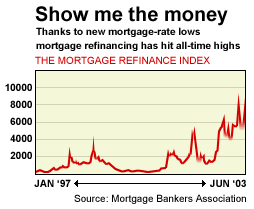NEW YORK (CNN/Money) - Think stocks have gone too far, too fast? Think the rally has got out of hand, and the market is way too expensive?
You may be right, but with all the country's cash spigots cranked open, things could get a lot nuttier. Indeed, today's environment is beginning to look similar to what prevailed in 1999, when a huge influx of money into the global economy helped fuel an 86 percent rise in the Nasdaq.
There's plenty of dough hitting the economy now, and it looks like there will be plenty more on the way. The Fed has put its overnight target rate at a 40-year low of 1.25 percent and looks set to lower it to 1 percent when it next meets in three weeks.
More important, the Fed has engineered a sharp move lower in long-term rates by signaling that it does not plan to raise rates until well after the economy starts growing strongly. Already, the effects of this have started to show. Mortgage and refinancing activity have both hit all-time highs. Corporations, too, are getting into the act, refinancing their higher yielding debt and freeing up cash.

Then there is the tax cut, which Goldman Sachs estimates will push $210 billion into the economy over the next five quarters.
"The idea is to get top-line growth going again," said Aeltus Investment Management strategist Jim Griffin. "But if you do that as an intermediate step, or side effect you're going to pump a lot of money into financial assets."
There are, after all, only a few things you can really do with money. You can stuff it into the mattress, you can spend it, or you can buy an asset. The low funds rate makes the mattress option less appealing -- money markets and savings accounts don't throw off much of a return these days. Spending takes time to rev up. So the money gets parked in some sort of asset -- gold (which is going up), bonds (which are going up), houses (which are going up) or stocks (which are going up).
"When you print money, it's going to inflate some asset price," said Northern Trust chief U.S. economist Paul Kasriel. "Maybe we'll revert to the late 1990s and buy stocks with it."
Turn off the bubble machine
Many observers credit the easy money policies of the Fed and other central banks with fueling the late '90s stock bubble. First, worries over the health of the world's financial system in the wake of the Russian debt crisis provoked the Fed to lower rates sharply, and then concern that Y2K would prompt a run on banks made it keep them low. Money supply rocketed higher and much of that money went into stocks -- particularly the most speculative ones. A similar expansion of the monetary base in Japan in the late 1980s helped feed speculative action in stocks and real estate.
So far, points out Dresdner Kleinwort Benson global investment strategist James Montier, we're not seeing anything quite as extreme as the financial conditions that prevailed in late-1980s Japan or late-1990s America. Rather, he thinks the market is rallying in anticipation of such conditions prevailing again.
"This is all in anticipation of the fact that the Fed can and will refuel the bubble," he said. "The market is playing the greater fool theory."
The greater fool theory is what develops whenever the market gets overtly speculative. Investors buy overpriced assets under the belief that there is some "greater fool" who will buy them later at some even more inflated price. Only in this case it seems like the Fed is trying to create conditions where investors can feel comfortable that the greater fool will be out there.
In doing this, the Fed could be the greatest fool of all. Easy financial conditions cannot last forever and when things shift, investors could be in for another great reckoning. For the economy, this would be a horrible turn of events, made worse by the fact that the Fed would have little of the credibility necessary for it to right things again.
But Griffin thinks that while this is true, it's important not to get too far ahead of yourself in your thinking. The money is just beginning to hit the market, players who didn't catch on to what the dynamic was early are itching to get in, momentum investing appears to be back in favor and stocks could have further to run.
"There may be a bear market on the other side of this," he said. "But it's too early to make that call. You can't see around corners."

|

